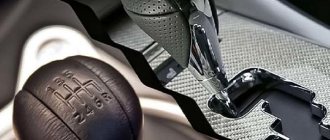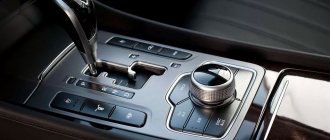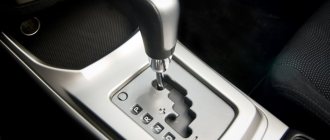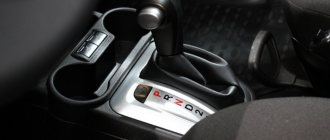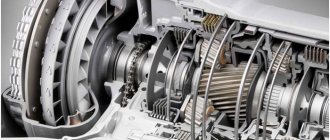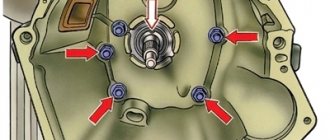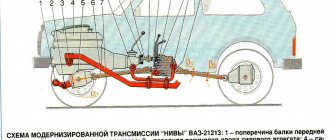The first automatic transmissions began to appear en masse on cars about 30 years ago. Automatic transmissions of that time were controlled through the operation of hydromechanical drives, and simply did not use any electronic solutions in the design. Electronics were unnecessary at that time.
Such a device allowed the machines to provide an amazing service life, which was about 300 thousand kilometers, subject to simple maintenance rules. Modern boxes cannot boast of such a resource, although they have become much more efficient, convenient and functional.
One of the brightest automatic transmissions are adaptive boxes. They have a special design and different operating modes. This allows them to work in optimal mode, depending on certain operating conditions.
Automatic transmission reset, calibration and adaptation
Automatic transmission adaptation is a process that occurs on modern automatic gearboxes without the participation of the car owner.
That is, the automatic transmission gets used to the driver’s driving style. On older models of the machine, adaptation had to be done manually. However, if you have done a major overhaul of the automatic transmission, then you will have to discard the old adaptation so that the automatic transmission gets used to the driver again. Today we’ll talk about how to do this and why adaptation is needed in general.
About the main types of gearboxes
It is an integral part of any car. The gearbox, or gearbox for short, is involved in transmitting torque from the engine to the wheels. In fact, in its simplest form, it is a gearbox with spur gears, designed to change the amount of torque coming from the engine. However, a modern gearbox and its design bear little resemblance to such a gearbox. Now there are several different versions of it that exist and are used on cars:
Manual transmission (manual transmission). It most closely corresponds to the traditional design, in which the transmitted torque is changed manually, for which the driver depresses the clutch and changes the position of the control lever, as a result of which the gears in mesh change. It is stepwise, i.e. the value of the torque coming from the engine changes by some amount in steps. The advantage of such a gearbox is its ease of manufacture, reliability and the ability for the driver to select the desired vehicle driving mode.
Automatic transmission (automatic transmission) or, as it is also called, automatic. It is a further development of the manual transmission. The automatic transmission changes gears without driver intervention. In this case, the magnitude of the transmitted torque also changes stepwise. There are various design options for how an automatic transmission is implemented, but the stepwise principle of changing the torque coming from the engine is, as a rule, preserved.
The machine provides the driver with:
- additional comfort when driving a vehicle, because there is no need to be distracted by gearshift changes;
- timely changes in transmitted torque;
- reduced fuel consumption and good acceleration dynamics.
- A CVT transmission can be considered one of the varieties of both automatic and independent gearboxes. It carries out a stepless change in the magnitude of the torque in accordance with the current load and developing driving conditions.
These types of gearboxes are most often installed on modern cars, but such devices can be completely different, significantly different from those described. It is worth keeping in mind that the other side of the complication of the original design will be the increased cost of new units, as well as the increasing costs of their maintenance.
Why adaptation is needed
Do you know why automatic transmission adaptation is needed? Write in the comments.
Today you can only find non-adaptive boxes on cars from the 80s and early 90s. New adapted automatic machines replaced the old ones, which could not automatically adapt to the driver’s driving style.
What was this for? You ask. Automatic adaptation makes it easier for the driver to move the vehicle and control it. Sitting behind the wheel, you will no longer feel jerks when accelerating if you sharply pressed the gas pedal and the automatic transmission did not have time to change gears and quickly pick up gears from first.
- the speed switching frequency decreases. The machine is not subject to constant wear of mechanical parts;
- the safety of driving on slippery roads and dirt roads where there is a possibility of getting stuck increases;
- reducing driver intervention. The machine itself understands when to slow down or what mode to turn on.
Attention! From the driver's side, it can be difficult to distinguish important points when slowing down or the danger of driving on a slippery road. Electronics quickly distinguishes between these moments and creates special conditions that protect the life of the driver and do not interfere with the operation of the automatic transmission in quiet mode, thereby increasing its service life.
Adapted automatic transmissions increase the smoothness of the ride; the electronics read the driver’s actions and get used to them, repeating or preparing in advance for the right moment.
Adaptive boxes have two learning modes:
- adaptation over a long period of time. The car must travel from 1,000 to 2,000 kilometers. Settings are set over a long period of time. The automatic transmission adapts to the average driving style, and the driver becomes one with the car;
- fast adaptation. The automatic gets used to the driving style in a short period of time from 100 m to 2 km. The automatic transmission adapts only to the moment of driving that is currently happening.
Old automatic transmissions have only one of the automatic learning modes. Accordingly, they are more stupid than modern ones.
If the machine begins to poorly obey the driver, pushing and kicking at the moment when it should smoothly gain or lose speed, then the problem may be not only a structural failure of the mechanism, but also in the “brains” of the machine.
This often happens after repairs, in the first days after the oil has been changed. This means that the machine is not adaptive and the adaptation needs to be reset.
Attention! I advise you to reset the adaptation after replacing the hydraulic plate, purchasing a used automatic transmission or car. I also recommend doing this procedure after extreme loads and winter driving.
Care instructions
There is no point in perceiving adaptive transmissions as something unusual, new and previously unseen. These are the same automatic transmissions, but with expanded capabilities and sophisticated electronics.
Although the electronic filling has complicated the box itself as an electronically dependent unit, in some places the design has been simplified. After all, on such automatic transmissions, various buttons and switches for different modes, which on conventional automatic transmissions were turned on and off manually, have disappeared.
Therefore, there are no special care recommendations intended specifically for adaptive boxes. They are looked after in the same way as any automatic transmission. It is necessary to periodically change or add transmission lubricant, as recommended by the manufacturer. If you change the oil on time and choose high-quality compounds, most problems and troubles can be prevented.
Try not to overload the automatic transmission, change the consumable fluid on time, according to the rules prescribed by the car manufacturer, monitor the condition and quantity of transmission oil. Periodic prevention is much simpler and cheaper than subsequent repair of breakdowns. In the case of adaptive transmissions, it is recommended not to bring them to a state of emergency, requiring complex repairs and replacement of elements. They are expensive, and there are some problems finding them on the domestic market. Some components have to be ordered and waited several weeks for delivery. You will not be able to operate the car all this time if the breakdown is really serious.
So far, the attitude of car enthusiasts towards adaptive automatic transmissions is quite ambiguous. They allow you to obtain certain advantages, increase comfort and efficiency. At the same time, such automatic transmissions do not always quickly and adequately respond to changes in operating mode and driving style, which causes delays that provoke some discomfort and inconvenience for drivers. The system is complex, but not fully thought out and perfected. Manufacturers have a lot of work to do so that the adaptive machine can quickly and accurately adapt to specific conditions.
Basic adaptation parameters
Most modern automatic transmissions do not have special buttons for switching modes. This makes driving easier for the car owner. The main thing is that the chip with the program embedded in it works properly in the automatic transmission.
- driving style. The automatic transmission independently adjusts to engine operation and responds to frequent pressing of the pedal by the driver’s foot. Protects against excessive fuel consumption, which can occur as a result of constant changes in speeds;
- acceleration dynamics. The automatic transmission remembers how the driver likes to start and repeats these actions next time. As a result, the driver receives smooth control of the car without jolts or jerks;
- braking style. If the car owner likes to brake sharply, then the box resets three gears immediately after pressing the pedal. These actions go unnoticed by the driver.
The automatic transmission can recognize winter conditions. For example, if the wheels slip, winter mode is activated. Understands when the car is moving uphill. During this process, a lower gear is engaged.
What is the difference between regular and adaptive machines?
Do you know that adaptive boxes and regular ones have significant differences? Read about it below.
A regular automatic transmission does not have any downshifts. The manufacturer puts in it 2500 rpm, at which it must switch to a new speed mode, and sooner or later than reaching this number it will not make the transition.
On regular automatic transmissions, the driver will be able to find buttons for simulating overdrive and sport mode. There is nothing like that on adaptive ones. The transition from one mode to another is performed by command from a computer, not a person.
Source
Adaptive automatic transmission (automatic). What is it, how does it work. A few words about training
Modern automatic transmissions are not at all similar to their predecessors that were 20 - 30 years ago. At the dawn of their appearance, they were completely controlled by hydromechanical drives and there simply were no electronics! Their reliability was off the charts, they easily lasted 200 - 300,000 kilometers, the main thing was to have proper maintenance, change the oil and filter. BUT modern automatic transmissions are far from this; they have quite a lot of electronics that control the box. Today's automatic machines, almost all of them are adaptive, they adapt to the driver's driving style and to certain conditions (“city-traffic jams”, “highway-overtaking”, etc.). But sometimes they are wildly “stupid”, although they can be cured of this by simple “training”. In general, today everything is in order, it will be interesting...
Automatic transmission
An automatic transmission involves automatic gear shifting, which does not require driver participation in this process. That is, if with a manual transmission the car owner must press the clutch and work with the shift lever to change the speed mode, with an automatic transmission the car independently selects a gear.
As a rule, with any installed gearbox, a step mechanism for changing the torque coming from the engine is retained.
Why adaptation is needed
The answer is simple: this function provides the most comfortable driving conditions throughout the entire range of speed characteristics. This becomes possible thanks to the use of the electronic component, it controls:
- Acceleration dynamics (calm or accelerated acceleration)
- Driving modes. With the gas pedal position unchanged, a higher gear saves fuel
- Acceleration modes. During sudden acceleration, the sports program is activated
- Braking modes. During sharp braking modes (sports braking), the automatic transmission shifts “down” to several gears at once.
Thus, the operation of the box becomes clearer and more thoughtful. It's not always simple though.
Do I need to reset the engine settings?
It is believed that along with resetting the gearbox, the same work needs to be done for the engine. It's a delusion. Lubrication in the engine and transmission serves different functions.
In the first case, we are talking about cooling and lubrication of the CPG mechanisms (cylinder-piston group), and in the second, we are talking about ensuring the transmission of torque and gear shifting.
At the same time, there are no parts in the engine that would adapt to the quality of the lubricant. These settings are not made in the engine control unit program.
Adaptive gearbox - what is it?
If previously a motorist needed to change gears independently, today an automated gearbox independently engages one or another gear, determining the most optimal one, following certain algorithms.
Adaptive gearbox - what is it?
An automated transmission is also known as an adapted or automatic transmission.
Automatic switching of driving modes is possible thanks to electronics. The main computer takes into account:
- driver acceleration - accelerated or calm;
- preferred type of driving, in which a high gear is engaged to save fuel;
- preferred acceleration - if acceleration is fast, the program activates the sport driving mode;
- Preferred braking - if the driver presses the brake pedal sharply, the automatic transmission switches to sport mode with an early transition to lower gears.
After analyzing the driver's driving style, the computer selects certain speeds.
Adaptive automatic transmission - what is it?
Gearbox is an abbreviation for the term “gearbox.” Automatic transmission is an automatic transmission.
The transmitted torque changes in steps, which can cause some inconvenience during emergency braking or rapid acceleration. Although there are various automatic transmission options, the automatic transmission can only shift gears alternately. A manual transmission allows you to change the speed at your discretion to a more optimal one in different situations. For example, you can immediately switch from third gear to fifth.
Today, almost all cars are equipped with an automatic transmission, which, according to a certain group of drivers, is much more convenient than a regular one. However, the convenience of an automatic transmission is a relative concept.
Adaptive gearbox: pros and cons
The main advantages of an automated transmission include the following:
- Automatic transmission creates more comfortable driving conditions;
- speeds are switched automatically according to a certain algorithm - depending on the speed of the vehicle, road conditions, etc.
- Fuel consumption is reduced by selecting speeds and modes.
The disadvantage of the automatic transmission is that the mode is incorrectly determined in some cases, which causes some inconvenience to the driver on bad roads where various maneuvers are needed.
Adaptive automatic transmission: options
The speed determination algorithm and the design of the adapted gearbox may differ significantly depending on the car model. Cheaper middle-class cars are equipped with an automatic transmission with a minimum number of modes. In total, there are three main modes: economical, standard and sport. The cooler the vehicle, the more programs are “sewn” into the automatic transmission.
Special automatic transmissions have been developed for racing cars that shift speeds only in sequential mode. From fourth gear you can go to fifth or third. This automatic transmission is called sequential.
A conventional manual transmission allows you to switch between gears from any speed, for example, from second to fourth or from fifth to third.
In some cases, the automated transmission may “forget” the driver’s driving style. In this case, the driver needs to drive several kilometers along different sections of the road for the computer to re-record the information.
Advantages and disadvantages
There is no limit to perfection. And the current adaptive boxes are certainly far from ideal. It will still take quite a lot of time to achieve optimal results in the operation of these transmissions.
If we talk about current adaptive machines, we can highlight several main advantages:
- The ability to create comfortable conditions during the operation of the vehicle;
- Speed switching is carried out in certain programmed algorithms, when choosing one of which the speed of movement, the condition of the surface, the intensity of pedaling, etc. are taken into account;
- Modes change independently. The driver does not need to press any buttons or levers;
- Minimum number of buttons and controls on the box;
The ability to reduce fuel consumption, which is ensured by the selection of gears and operating modes.
But not everything is so perfect. Adaptive automatic transmissions have their drawbacks. The main disadvantage is the imperfection of the adaptation system, which is not always able to correctly adapt to the driver’s requirements. This is clearly manifested when one driving mode is replaced by another. For example, when the driver was moving in slow, dense traffic, and then drove onto an open highway and wanted more dynamics. Or vice versa. It takes some time to rebuild and adapt, sometimes measured in several minutes or kilometers.
Also, the adaptive system does not always show its best side when driving on bad roads, where there are rather sharp transitions from normal surfaces to various uneven surfaces, bumps and holes that need to be avoided and maneuvered.
Another drawback is the issue of maintenance. In Russian conditions, there are some problems with maintenance and finding spare parts. Since adaptive automatic transmissions are actually a type of automatic transmission, but with more complex electronics, finding and purchasing some parts can be problematic. This requires more time and financial resources.
How long does it take for the automatic transmission to adapt?
I would like to note that different manufacturers have different ways:
- There are automatic transmissions in which adaptation occurs after a few minutes or kilometers. It is enough to drive for about half an hour in aggressive mode or in quiet mode and the transmission will get used to it.
- However, there are other types that can accumulate algorithms over long runs, for example over the last 300 or even 1000 kilometers. And then, in certain situations, act according to this algorithm. It is very difficult to train such people.
Problems during the procedure
Adaptation of automatic transmissions became possible thanks to the emergence of complex electronic systems that continue to be improved and developed. The complexity of these systems, aimed at increasing traffic comfort and safety, is fraught with potential risks and possible problems.
Problems that arise during the operation of an automatic transmission or its adaptation are in most cases associated with the operation of the ECU, with failures of its program logic circuits or technical elements. The causes of the latter may be short circuits as a result of damage to the insulation or integrity of the housings, overheating or the ingress of moisture, oils, dust, as well as voltage surges in the vehicle’s on-board network.
The versatility of the robot is a great feature
Toyota Corolla with robotic gearbox
Analyzing all the advantages and disadvantages of robotic gears, we can confidently say that this type of transmission has adequately “settled” in Toyota cars. With such a box, you can forget about changing gears, while the control unit will do all the “manual work” for you. The Japanese are trying to equip budget and premium models with a robot box. And there's nothing wrong with that. The main thing is to always undergo maintenance on time to avoid costly breakdowns.
The universal robot box consists of:
- mechanical transmission and clutch
- automatic transmission and gear drive
- electrical control unit (ECU)
The peculiarity of the robotic transmission is its versatility. Ensuring uninterrupted gear shifting is carried out using electronic systems. The operation of such a transmission is provided in automatic or semi-automatic mode. Also, each car has the ability to switch to manual control. For the correct and convenient functioning of the box, you need to adapt the Toyota Corolla robot with your own hands or at a car service center.
Why is the adaptive automatic transmission STUPID?
Some people write to me that after a traffic jam of 30 - 40 minutes, the transmission does not seem to work normally. She really is “STUPID”; there’s no other way to describe it. You press on the gas pedal, but there is NO acceleration dynamics. It’s just that she adapted to the traffic jam and made the gears longer so as not to constantly switch them. To reduce wear on the automatic transmission
There are other situations - when you are “frying” along the highway, gears begin to quickly shift and downgrade. You drive into the city and the responsiveness is excellent, the acceleration dynamics are also great. BUT after a certain time in city mode, the automatic transmission again becomes “normal” as it worked.
If you almost always like dynamic driving, then “STUPID” usually scares you.
Friends, don’t be afraid, as a rule, you get out of a traffic jam, drive a few minutes or kilometers in the dynamic range and the automatic transmission is restored.
This process is called “learning”, when our machine remembers the desired driving mode.
Operating modes
As noted earlier, the automatic adaptive transmission adapts to the driver's specific driving style. Depending on acceleration, braking, acceleration, intensity of operation of the gas and brake pedals, the electronics selects the required optimal mode.
Moreover, the operation of such transmissions can be carried out in several of the most common modes:
Each of them has its own characteristics.
- Economical operating mode. If the driver adheres to a moderate driving style with his vehicle, the electronics switches to economy mode. The main objective of this mode is maximum fuel economy. During operation of the car, smooth and gradual acceleration is observed, the car does not move away when you press the gas pedal. Mostly the automatic transmission electronics select lower gears. A relevant mode for those who often drive in urban environments, are forced to sit in traffic jams, face heavy traffic and comply with speed limits;
- Sports mode. For more aggressive drivers who like to accelerate quickly and drive at high speeds, the electronics provide the option of switching to a sport program. It is aimed at forced control, the fastest possible acceleration, and excellent dynamics. In addition to quickly accelerating, in this mode the car will also brake quickly. When switching to the vehicle's sport mode, the adaptive transmission extracts full power from the engine. As a result, the car starts quickly and actively gains maximum speed. In parallel, this leads to increased fuel consumption. There is no longer any talk about any priority for saving fuel;
- Winter operation mode. An extremely useful and effective option for adaptive automatic transmission programming. With its help, the car adapts to movement on the road surface, which is characterized by the presence of a layer of snow or ice. Special programs allow the car to start moving almost without slipping. At the same time, acceleration and braking are moderate, without sudden jerks and kicks. At the same time, the program includes the possibility of an emergency stop. Here the braking is carried out by the engine. This function is aimed at reducing the braking distance when braking on a slippery surface. In winter mode, there is no clear priority for automatic transmission gears. The only exception can be called the start. In this state, the adaptive gearbox prefers to start off primarily in 2nd or 3rd gear.
Device Features
Much in terms of design and device depends on the specific automaker. Competition forces the introduction of some proprietary solutions that distinguish the box of one manufacturer from another.
But if we talk about what an adaptive automatic transmission is, then we should take into account certain similarities between all similar automatic transmissions. The first step is to use a torque converter. It includes paddles mounted on 3 wheels. Gear drives are also used, the majority of which are planetary.
The true difference and the main essence of adaptive devices lies in the electronics. The electronic units have approximately the same design, some look almost identical. But each manufacturer has its own set of programs, filling and electronic brains.
It wouldn’t hurt to compare a regular machine gun and an adapted one. In the first case, we are talking about pre-programmed speed switching. Yes, all manufacturers may have slightly different approaches to programming, but the essence always remains the same. Switching occurs at approximately 2500 rpm. When this mark is reached, a transition occurs from one speed to another. At the same time, there is no need to talk about economical or increased speed in standard operating mode.
To change the switching program on conventional automatic machines, manufacturers provide a transition to different modes such as economical, sports, off-road, etc. But this does not happen automatically. The box changes the style of its operation, otherwise it changes gears only after manually changing the mode. This is not an adaptation, just a manual adjustment. To return to the economy mode again or to transfer the box to urban operating conditions, you will need to manually switch from one mode to another.
A distinctive feature of the adaptive transmission is the absence of various buttons and settings, as well as all kinds of modes that need to be turned on and switched. The electronics remembers your driving style and regulates everything necessary independently. This explains why adaptive devices use a minimal number of buttons and switches.
If the driver prefers economical and careful driving, the box will consider this, understand it and work in the appropriate mode. If the driver prefers more aggressive driving, then gear shifting will occur at higher speeds.
Education
Motorists who have experience in operating cars with an adaptive transmission note that during long periods of downtime in traffic jams, the operation of the automatic transmission changes; it ceases to be the same as before getting into heavy traffic.
In fact, the box changes its mode. When you press the gas pedal, the acceleration dynamics are significantly reduced; it is not possible to accelerate normally, as the driver is accustomed to under normal conditions. All this is due to the fact that the electronics adapt to traffic jams, where minimum speeds, slight acceleration and short dashes followed by braking are needed. The automatic transmission has switched to a longer shift mode, which is aimed at reducing the number of shifts themselves and reducing wear on transmission elements.
Automatic transmission training
As I mentioned above, training depends on many parameters, as well as on the very structure of the machine and its electronics (algorithms).
On one, you just have to pull out of a traffic jam and press the gas for a few minutes (dynamic driving) and it will switch from a vegetable to a sporty ride.
But there is training when you need to carry out special manipulations, because the algorithm is calculated based on the last, say, 200 kilometers. You bought such a car, but it doesn’t work for you, it’s better to reset everything to factory settings.
- The first option is the dealer, he will be able to reset the adaptation. And even upload other factory firmware. BUT this is not the case for all manufacturers.
- As they call it on the forums – “collective farm training”. This is when several different manipulations seem to reset the adaptation, for example - turn on the ignition - hold the gas pedal (30 seconds) - then the brakes (30 seconds) - release and turn off the ignition. It is reliably known that this is how Mercedes is chipped in. Here is an example video.
- There is another training option - it will be of interest to owners of AVEO (T300), and I think also to other Chevrolets that have a 6T30/40/45 automatic. They have a manual mode - the essence of which is to switch to “M”, then we change gears as we need, that is, so that first – second – third and others shift faster, we press the “plus sign” on the lever, that is, we work instead of an automatic transmission. The automatic transmission remembers the algorithm and after you return to the normal “D” mode (after 20 - 30 minutes), the shifts will be very similar to your manual ones.
Why is it advisable to use dealer scanners?
In continuation of the above thoughts. To reset the memory in the automatic transmission control unit, you need a diagnostic tool - a dealer scanner. It contains software that provides cleaning to factory settings.
During operation, all changes that were made to the memory while using the vehicle are deleted. But you need to understand that there are many fakes on the market, so it is important to focus only on original interfaces.
The use of dealer scanners that have not been certified is dangerous. This is due to the fact that they do not clear the control unit’s memory to factory settings or perform the work with errors.
The practice of using such devices has only confirmed that the operation of such equipment is incorrect, and a lot of “garbage” remains in the memory.
In many cases, the work is simply imitated without making any changes.
This fact is confirmed by service station specialists who regularly encounter similar difficulties.
Automatic transmission adaptation reset. We will consider KIA and Hyundai
Automatic transmission sometimes requires adaptation reset. For example, when you have changed the oil or are experiencing glitches, it is advisable to perform this operation. This will really extend the life of the unit and also save you from bugs. In this article (as usual there will be a video version below), I will tell you how to do this procedure on a KIA car (I have a six-speed automatic). However, the same algorithm is also suitable for Hyundai cars, because they have the same transmissions. There are many controversial issues that I want to touch on in these materials...
THE CONTENT OF THE ARTICLE
Many people say that it is no longer necessary to adapt automatic transmissions; these are relics of old 4-gear transmissions. I agree partly, but only partly. Still, sometimes it’s even useful to do. Now everything is in order
What is the difference between regular and adaptive machines?
And everything is simple here. Ordinary automatic transmissions are programmed for a certain gear shift (different manufacturers have different ways), but the essence is the same - they set the shifts at 2500 rpm and it switches to them, there are no lower economical rpms for you, nor are there any increased ones. Manufacturers, of course, install various simulating modes - such as ECO (economical), SPORT (sports), OD (overdrive), etc., but all of these are essentially manual adjustments of the machine, no adaptation, all by hand!
Adaptive automatic machine, does not need buttons or settings, does not need any modes; it will remember everything and adjust it itself. That’s why on such machines there are a minimum of buttons, like mine, look at the photo, there is no sports, no economy mode!
If you like to “save”, then it will get used to it; if you like to “drive”, after a certain mileage it will switch at higher speeds.
As I wrote above, you can determine such an automatic machine yourself, using a minimum of buttons and modes on the lever and the blog next to the automatic transmission handle. Well, in terms of changing behavior.
Now we are watching a short video.
That's all, I think my article was useful for you, tell your friends about it on social networks, this is the best gratitude for our blog.
Similar news
- Types of gearboxes, ordinary cars, as well as their differences.
- The automatic transmission stalls and kicks slightly. Why and what's going on...
- Hardware or partial oil change in automatic transmission. How to do it right...
Add a comment Cancel reply
Ways to quickly adapt the machine to your needs
Few people know, but if necessary, automatic transmission adaptation can be carried out in an accelerated mode (naturally, we are talking about setting a constant operating mode for the automatic transmission, which is formed over the long-term operation of the car). Such a measure should not seem unnecessary, because its implementation is quite reasonable if:
- The motorist has received an automatic transmission that was previously adapted for another person, and it needs to be reconfigured;
- The machine began to work incorrectly, kick and often become “stupid”, but with its technical component everything is fine;
- After a major overhaul, the box has reset its usual settings or simply refuses to adapt to the new driving style.
As you can see, there is no need to come up with situations for forced training of an automatic transmission for a new way of working, they all lie on the surface. But how to adapt the machine efficiently and quickly? There are actually several ways:
- Option one - we give the machine for flashing. Everything here is extremely simple. The driver tells the technicians what driving mode he wants to adapt the automatic transmission to, and they, in turn, re-program its chip;
- Option two – we carry out forced adaptation. Here everything is more complicated, because you will have to find technical documentation for the automatic transmission being trained. As a rule, for forced learning it is necessary to first reset the existing adaptation and then “fill in” a new one. Different boxes conduct this type of training differently. For example, let's look at the forced adaptation of a Mercedes automatic machine. It is often done like this:
- The car warms up, turns off for 5-10 seconds, starts again (we repeat two or three times);
- Then the brake is pressed, the automatic transmission is switched to manual control mode, modes and gears are switched on in turn (in the order in which they should work in the future);
- After this, the car starts, smoothly accelerates to 40 km/h, turns off, starts again, smoothly accelerates to 80 km/h, turns off, starts again and the car drives for 5-7 kilometers.
This completes the adaptation. By the way, with such a setting you can make the operation of the adaptive box more sporty or, on the contrary, softer.
If you have plenty of time, then resorting to forced adaptation of the machine is pointless. It’s much easier to drive a few hundred kilometers in your own style and let the automatic transmission get used to it.

